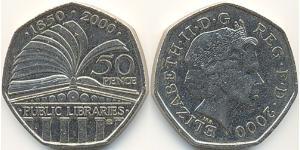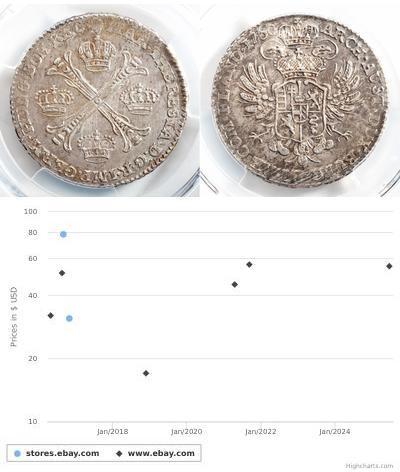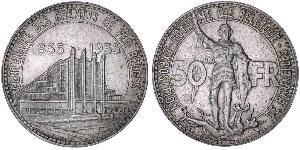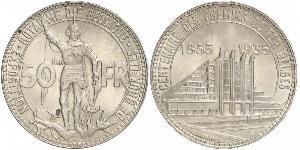(售价 $25.0)
1996, Spain (Republic). Large Proof Silver 5 Ecu "The Mataro Ship Model" Coin.
Mint Years: 1996
Mint Place: Madrid
Denomination: 5 Ecu
Mintage: 43,802 pcs.
References: KM-XM17.
Condition: Proof in original plastic capsule!
Weight: 33.6gm (0.9998 Oz. Pure Silver!)
Material: Sterling Silver (925)
Diameter: 42mm
The European Currency Unit (₠ or ECU) was a basket of the currencies of the European Community member states, used as the unit of account of the European Community before being replaced by the euro on 1 January 1999, at parity. The ECU itself replaced the European Unit of Account, also at parity, on 13 March 1979. The European Exchange Rate Mechanism attempted to minimize fluctuations between member state currencies and the ECU. The ECU was also used in some international financial transactions, where its advantage was that securities denominated in ECUs provided investors with the opportunity for foreign diversification without reliance on the currency of a single country.
The ECU was conceived on 13 March 1979 as an internal accounting unit. It had the ISO 4217 currency code XEU.
On 1 January 1999, the euro (with the code EUR and symbol €) replaced the ECU, at the value €1 = 1 ECU. Unlike the ECU, the euro is a real currency, although not all member states participate (for details on euro membership see Eurozone). Two of the countries in the ECU basket of currencies, UK and Denmark, did not join the eurozone, and a third, Greece, joined late. On the other hand, Finland and Austria joined the Eurozone from the beginning although their currencies were not part of the ECU basket (since they had joined the EU in 1995, two years after the ECU composition was "frozen").
Due to the ECU being used in some international financial transactions, there was a concern that foreign courts might not recognize the euro as the legal successor to the ECU. This was unlikely to be a problem, since it is a generally accepted principle of private international law that states determine their currencies, and that therefore states would accept the European Union legislation to that effect. However, for abundant caution, several foreign jurisdictions adopted legislation to ensure a smooth transition. Of particular importance, the USA states of Illinois and New York adopted legislation to ensure a large proportion of international financial contracts recognized the euro as the successor of the ECU.
One of the oldest and most famous medieval ship models in Western culture is the Mataró. Presently housed in the Maritime Museum Rotterdam based in the Netherlands, this Mediterranean trading ship was built in the 15th century according to recent carbon date testing. What makes the Mataró so remarkable is it is believed to have been presented to the Chapel of San Simón in the Spanish town of Mataró as a dedicated gift to the Virgin Mary.
In fact, most chapels during this time were often decorated with gifts of model ships. These gifts are more commonly known as ex votos, or votive offerings to a saint or divinity. Ex votos are given in fulfillment of a vow or devotion and are placed in churches where worshippers seek grace or wish to show gratitude. Sailors or other people who traveled by sea would place ex votos in the form of paintings, as well as ship models, in designated shrine areas and ask for blessings on their oceanic voyages.
More than 48 inches long and 22 inches wide, the Mataró model has been used as a basis for naval architecture research. Additionally, it has been used as a guide to determine cargo capacity, functional structures and engineering elements of ships that may have existed in the 1400s. A great deal of attention has been put into the Mataró’s details and the model itself was more than likely built by an actual shipbuilder. All historical evidence indicates that the Mataró is a scale model of an actual ship.
Unfortunately, church records of the Mataró were lost during the Spanish Civil War and no sources have been located that can provide indelible proof that it was truly presented as an ex voto. For instance, models of other ships, paintings and relics have been placed in churches for decoration or for commemoration and not necessarily just for the purposes of an ex voto blessing.
Truth be known, votive ship models are well documented through out history. To date, more than 165 votives have been discovered during archaeological excavations dating from 800 CE to the 1800s. Keep in mind that prior to understanding the Gulf Stream and barometric pressure, it was believed that God made storms at sea. Because sailors spent the majority of their time at sea, most felt that it was imperative to recognize a devotion to the god of the sea through the presentation of ex voto ship models.
A visit to Notre Dame de Grâce chapel situated in Honfleur on the Normandy coast reveals a mariner’s sanctuary that is filled with ship models. Dating back to 1600, seafarers made pilgrimages to this chapel and offered ex voto ship models for safe returns from their perilous journeys. Examples of the miniature vessels hang from the churches beams to this very day. Travel to other European coastal town churches unveil a multitude of ex voto ship models. Furthermore, King Edward III is known to have left a ship model at his father’s gravesite when he was spared from a shipwreck.
Not all ship models were elaborately constructed. Many were quite sparse and crude in design. Depending upon artistic ability, education level and other cultural variants, ship models could be as simple as a hollowed out oblong-shaped bowl. Although some model shapes do have full-sized counterparts, there is still a large amount of information needed to interpret and record ship model data correctly.
Based on historical findings, archaeological evidence and religious trends, it can be assumed that ex voto ship models were meant as signs of appeasement and protection. They should not be confused with talismans, which are associated with superstitious offerings. Ex votos are actions or material things that are literally vowed to God in return for a hoped-miracle or the answer of a prayer. In Latin, ex voto translates into ‘in fulfillment of a vow’ and it is quite evident that that is precisely what these ship models were intended to be.
50 Franc 比利时 銀
本组有 34 钱币 / 33 售价
⇑
























